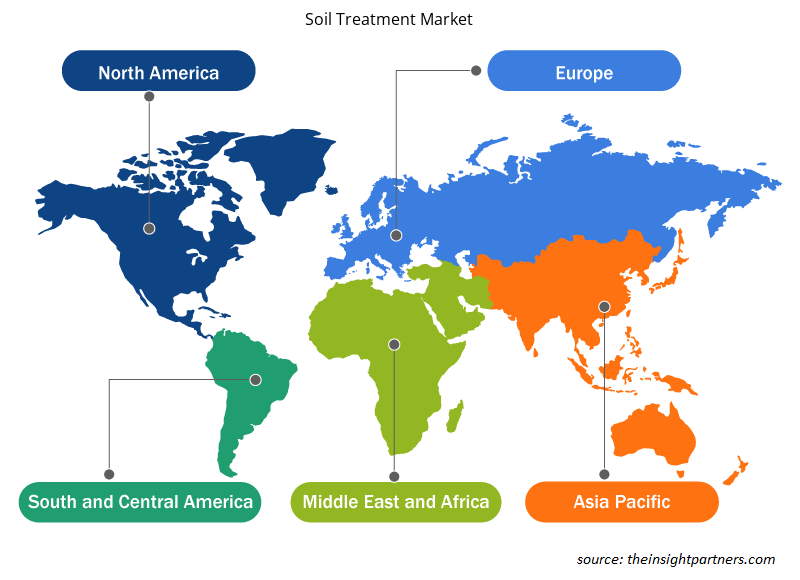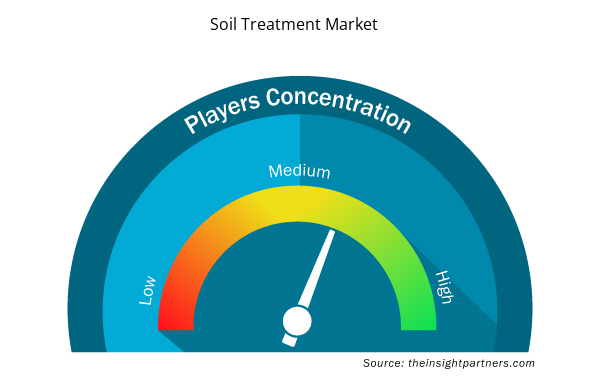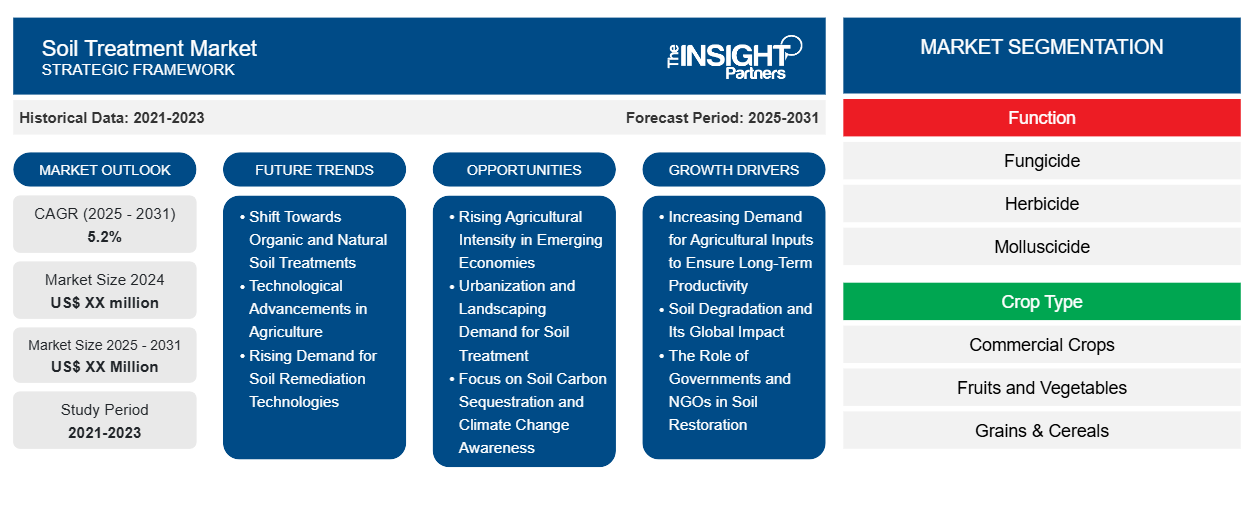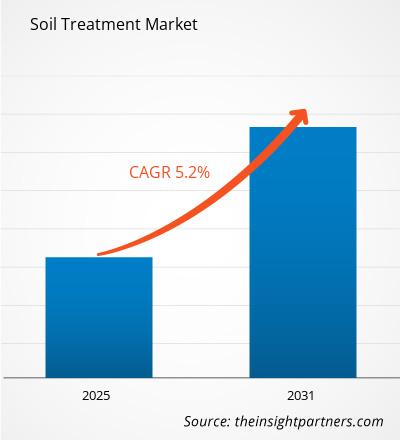Le marché du traitement des sols devrait enregistrer un TCAC de 5,2 % de 2024 à 2031, avec une taille de marché passant de XX millions USD en 2024 à XX millions USD d'ici 2031.
Le rapport est segmenté par fonction (fongicide, herbicide, molluscicide, insecticide et nématicide). Le rapport présente en outre une analyse basée sur le type de culture (cultures commerciales, fruits et légumes, céréales, légumineuses et oléagineux, gazon et plantes ornementales). Le rapport couvre cinq régions : Amérique du Nord, Europe, Asie-Pacifique, Moyen-Orient et Afrique, Amérique du Sud et centrale et pays clés de chaque région. L'analyse mondiale est ensuite subdivisée au niveau régional et par principaux pays. Le rapport offre la valeur en USD pour l'analyse et les segments ci-dessus.
Objectif du rapport
Le rapport sur le marché du traitement des sols de The Insight Partners vise à décrire le paysage actuel et la croissance future, les principaux facteurs moteurs, les défis et les opportunités. Cela fournira des informations à diverses parties prenantes commerciales, telles que :
- Fournisseurs/fabricants de technologie : pour comprendre l’évolution de la dynamique du marché et connaître les opportunités de croissance potentielles, leur permettant de prendre des décisions stratégiques éclairées.
- Investisseurs : Effectuer une analyse complète des tendances concernant le taux de croissance du marché, les projections financières du marché et les opportunités qui existent tout au long de la chaîne de valeur.
- Organismes de réglementation : Réglementer les politiques et surveiller les activités du marché dans le but de minimiser les abus, de préserver la confiance des investisseurs et de maintenir l’intégrité et la stabilité du marché.
Segmentation du marché du traitement des sols
Fonction
- Fongicide
- Herbicide
- Molluscicide
- Insecticide
- Nématicide
Type de culture
- Cultures commerciales
- Fruits et légumes
- Grains et céréales
- Légumineuses et oléagineux
- Gazon et plantes ornementales
Personnalisez ce rapport en fonction de vos besoins
Vous bénéficierez d'une personnalisation gratuite de n'importe quel rapport, y compris de certaines parties de ce rapport, d'une analyse au niveau des pays, d'un pack de données Excel, ainsi que de superbes offres et réductions pour les start-ups et les universités.
- Obtenez les principales tendances clés du marché de ce rapport.Cet échantillon GRATUIT comprendra une analyse de données, allant des tendances du marché aux estimations et prévisions.
Facteurs de croissance du marché du traitement des sols
- Demande croissante d'intrants agricoles pour assurer la productivité à long terme : La population mondiale en augmentation, le besoin en produits agricoles nécessite des apports plus importants dans le sol pour un traitement approprié afin d'assurer une productivité agricole à long terme et la disponibilité d'une production alimentaire durable. La fertilisation, l'ajustement du pH et les amendements organiques utilisés dans le traitement des sols sont essentiels car ils influencent la santé du sol et la maximisation du rendement des cultures et assurent la productivité agricole à long terme et l'amélioration de la production. Une production agricole élevée nécessite une solution plus efficace pour son traitement.
- Dégradation des sols et son impact global : La surexploitation des terres agricoles, la déforestation, l’industrialisation et le réchauffement climatique associés à la dégradation des sols menacent le monde. Les principaux défis rencontrés dans ce domaine comprennent l’érosion des sols, l’épuisement des nutriments et la contamination. Cela a nécessité l’adoption de mesures de conditionnement des sols, de contrôle de l’érosion des sols et de mesures de réhabilitation, augmentant ainsi la restauration et la conservation de sols sains. Les gouvernements, les ONG et les industries affiliées à l’agro-industrie ont intérêt à traiter les sols comme un moyen d’inverser les effets néfastes accumulés des conséquences d’une mauvaise gestion des sols.
- Le rôle des gouvernements et des ONG dans la restauration des sols : La sensibilisation croissante aux facteurs environnementaux et les réglementations gouvernementales strictes concernant le traitement des sols avec des produits agricoles durables favorisent l'adoption de produits de traitement des sols. Les traitements biologiques et respectueux de l'environnement, étant respectueux de l'environnement, sont le premier choix des agriculteurs car les clients ont tendance à avoir une utilisation minimale de produits chimiques dans l'agriculture et à éviter la pollution des sols et de l'eau. Les réglementations agricoles exigent que le traitement des sols adopte strictement les principes agricoles pour une agriculture sûre et saine.
Tendances futures du marché du traitement des sols
- L’évolution vers des traitements biologiques et naturels des sols : Les traitements biologiques et naturels des sols comme le compost, le biochar et les engrais à base de plantes sont en plein essor. Cela s’explique par le fait que les consommateurs préfèrent davantage de produits biologiques et que des réglementations environnementales plus strictes imposent une gestion non toxique et durable des sols. Les traitements biologiques des sols se développent également en raison de leur plus grande respect de l’environnement et de leur sécurité par rapport aux produits chimiques synthétiques.
- Progrès technologiques dans l'agriculture : les nouvelles technologies et leur adoption dans l'agriculture modifient la façon dont le sol est traité. L'analyse des données, les appareils IoT, les drones et autres capteurs dominent la capacité à pratiquer une agriculture de précision. Une surveillance ponctuelle de l'état du sol est également réalisée à l'aide de traitements ciblés. Ces technologies garantissent que les engrais du sol ne sont pas gaspillés en minimisant les déchets et en obtenant une efficacité générale optimale dans les applications réalisées dans le traitement des sols. L'utilisation de technologies plus accessibles est susceptible d'accroître la participation de cette technologie sur le marché du traitement des sols.
- Demande croissante de technologies de dépollution des sols : La demande croissante de technologies de dépollution des sols est déclenchée par la contamination des sols par des métaux lourds, des pesticides, des déchets industriels et d’autres polluants. La demande croissante de technologies de dépollution vertes telles que la bioremédiation et la phytoremédiation pour la décontamination et la régénération des sols pollués commence à montrer sa force sur le marché. Les principaux moteurs de cette tendance sont une meilleure conscience environnementale, une nouvelle législation concernant la pollution industrielle et la nécessité de terres propres et saines pour l’agriculture et les besoins urbains.
Opportunités de marché pour le traitement des sols
- L’augmentation de l’intensité agricole dans les économies émergentes : L’augmentation de l’intensité agricole dans les économies émergentes, notamment en Asie-Pacifique, en Amérique latine et en Afrique, accroît la demande de technologies de traitement des sols. Les problèmes qui assaillent ces économies émergentes – mauvaises pratiques de gestion des sols et surexploitation agricole dans de nombreuses régions – constituent des opportunités pour les entreprises spécialisées dans les technologies de traitement des sols, comme les amendements organiques, le contrôle du pH et la restauration de la santé des sols.
- Demande de traitement des sols dans le domaine de l'urbanisation et de l'aménagement paysager : Avec l'urbanisation et la commercialisation croissantes, le besoin de traitement des sols dans les projets d'aménagement paysager ne cesse d'augmenter. Il est devenu une exigence essentielle pour favoriser la croissance des plantes dans des conditions urbaines difficiles, allant des parcs urbains aux toits verts et aux terrains de sport. Les amendements du sol, les engrais et les matériaux de contrôle de l'érosion sont d'une importance vitale pour prendre soin de villes saines et durables. Cela devient à son tour une nouvelle opportunité de développement de marché pour les entreprises qui traitent le sol.
- Accent sur la séquestration du carbone dans le sol et sensibilisation au changement climatique : Parallèlement à la sensibilisation croissante au changement climatique, l’attention portée à la séquestration du carbone dans le sol augmente lentement mais sûrement. Parmi ces méthodes figurent de grandes quantités de biochar, de compost et de cultures de couverture, qui sont par conséquent capables d’améliorer la capacité de captage et de stockage du sol. Ces méthodes sont de plus en plus reconnues dans le cadre d’initiatives plus vastes d’agriculture du carbone qui ouvrent de nouvelles perspectives aux entreprises qui développent des traitements du sol soutenant les efforts de séquestration du carbone.
Aperçu régional du marché du traitement des sols
Les tendances et facteurs régionaux influençant le marché du traitement des sols tout au long de la période de prévision ont été expliqués en détail par les analystes d’Insight Partners. Cette section traite également des segments et de la géographie du marché du traitement des sols en Amérique du Nord, en Europe, en Asie-Pacifique, au Moyen-Orient et en Afrique, ainsi qu’en Amérique du Sud et en Amérique centrale.

- Obtenez les données régionales spécifiques au marché du traitement des sols
Portée du rapport sur le marché du traitement des sols
| Attribut de rapport | Détails |
|---|---|
| Taille du marché en 2024 | XX millions de dollars américains |
| Taille du marché d'ici 2031 | XX millions de dollars américains |
| Taux de croissance annuel composé mondial (2025-2031) | 5,2% |
| Données historiques | 2021-2023 |
| Période de prévision | 2025-2031 |
| Segments couverts | Par fonction
|
| Régions et pays couverts | Amérique du Nord
|
| Leaders du marché et profils d'entreprises clés |
|
Densité des acteurs du marché du traitement des sols : comprendre son impact sur la dynamique des entreprises
Le marché du traitement des sols connaît une croissance rapide, tirée par la demande croissante des utilisateurs finaux en raison de facteurs tels que l'évolution des préférences des consommateurs, les avancées technologiques et une plus grande sensibilisation aux avantages du produit. À mesure que la demande augmente, les entreprises élargissent leurs offres, innovent pour répondre aux besoins des consommateurs et capitalisent sur les tendances émergentes, ce qui alimente davantage la croissance du marché.
La densité des acteurs du marché fait référence à la répartition des entreprises ou des sociétés opérant sur un marché ou un secteur particulier. Elle indique le nombre de concurrents (acteurs du marché) présents sur un marché donné par rapport à sa taille ou à sa valeur marchande totale.
Les principales entreprises opérant sur le marché du traitement des sols sont :
- ADAMA Agricultural Solutions Ltée.
- Société américaine Vanguard
- Arkema SA
- BASF SE
- Traitement du sol de Kanesho
Avis de non-responsabilité : les sociétés répertoriées ci-dessus ne sont pas classées dans un ordre particulier.

- Obtenez un aperçu des principaux acteurs du marché du traitement des sols
Principaux arguments de vente
- Couverture complète : Le rapport couvre de manière exhaustive l’analyse des produits, des services, des types et des utilisateurs finaux du marché du traitement des sols, offrant un paysage holistique.
- Analyse d’experts : Le rapport est compilé sur la base d’une compréhension approfondie des experts et analystes du secteur.
- Informations à jour : Le rapport garantit la pertinence commerciale en raison de sa couverture des informations récentes et des tendances des données.
- Options de personnalisation : ce rapport peut être personnalisé pour répondre aux exigences spécifiques du client et s'adapter parfaitement aux stratégies commerciales.
Le rapport de recherche sur le marché du traitement des sols peut donc aider à ouvrir la voie au décodage et à la compréhension du scénario de l’industrie et des perspectives de croissance. Bien qu’il puisse y avoir quelques préoccupations valables, les avantages globaux de ce rapport ont tendance à l’emporter sur les inconvénients.
- Analyse historique (2 ans), année de base, prévision (7 ans) avec TCAC
- Analyse PEST et SWO
- Taille du marché Valeur / Volume - Mondial, Régional, Pays
- Industrie et paysage concurrentiel
- Ensemble de données Excel


- Digital Language Learning Market
- Intradermal Injection Market
- Sterilization Services Market
- Non-Emergency Medical Transportation Market
- Aircraft Landing Gear Market
- Emergency Department Information System (EDIS) Market
- Mice Model Market
- Greens Powder Market
- Adaptive Traffic Control System Market
- MEMS Foundry Market

Report Coverage
Revenue forecast, Company Analysis, Industry landscape, Growth factors, and Trends

Segment Covered
This text is related
to segments covered.

Regional Scope
North America, Europe, Asia Pacific, Middle East & Africa, South & Central America

Country Scope
This text is related
to country scope.
Questions fréquemment posées
Increased use of technological solutions (precision agriculture) is expected to be the key market trend.
The report can be delivered in PDF/Word format, we can also share excel data sheet based on request.
On the basis of geography, the soft magnetic composite market is classified into North America, Europe, Asia Pacific, Middle East and Africa, and South and Central America
ADAMA Agricultural Solutions Ltd, American Vanguard Corp, BASF SE, Bayer AG, FMC Corp, Nufarm Ltd, PI Industries Group, Rallis India Ltd, Syngenta AG, and UPL Ltd
The major factors driving the soil treatment market are:
1. Increasing Agricultural Demand and Food Security.
2. Soil Degradation and Erosion.
The Soil Treatment Market is estimated to witness a CAGR of 5.2% from 2023 to 2031
Trends and growth analysis reports related to Chemicals and Materials : READ MORE..
The List of Companies
1. ADAMA Agricultural Solutions Ltd.
2. American Vanguard Corporation
3. Arkema S.A.
4. BASF SE
5. Kanesho Soil Treatment
6. Monsanto Company
7. Novozymes A/S
8. Platform Specialty Products
9. Solvay S.A.
10. Syngenta AG
The Insight Partners performs research in 4 major stages: Data Collection & Secondary Research, Primary Research, Data Analysis and Data Triangulation & Final Review.
- Data Collection and Secondary Research:
As a market research and consulting firm operating from a decade, we have published and advised several client across the globe. First step for any study will start with an assessment of currently available data and insights from existing reports. Further, historical and current market information is collected from Investor Presentations, Annual Reports, SEC Filings, etc., and other information related to company’s performance and market positioning are gathered from Paid Databases (Factiva, Hoovers, and Reuters) and various other publications available in public domain.
Several associations trade associates, technical forums, institutes, societies and organization are accessed to gain technical as well as market related insights through their publications such as research papers, blogs and press releases related to the studies are referred to get cues about the market. Further, white papers, journals, magazines, and other news articles published in last 3 years are scrutinized and analyzed to understand the current market trends.
- Primary Research:
The primarily interview analysis comprise of data obtained from industry participants interview and answers to survey questions gathered by in-house primary team.
For primary research, interviews are conducted with industry experts/CEOs/Marketing Managers/VPs/Subject Matter Experts from both demand and supply side to get a 360-degree view of the market. The primary team conducts several interviews based on the complexity of the markets to understand the various market trends and dynamics which makes research more credible and precise.
A typical research interview fulfils the following functions:
- Provides first-hand information on the market size, market trends, growth trends, competitive landscape, and outlook
- Validates and strengthens in-house secondary research findings
- Develops the analysis team’s expertise and market understanding
Primary research involves email interactions and telephone interviews for each market, category, segment, and sub-segment across geographies. The participants who typically take part in such a process include, but are not limited to:
- Industry participants: VPs, business development managers, market intelligence managers and national sales managers
- Outside experts: Valuation experts, research analysts and key opinion leaders specializing in the electronics and semiconductor industry.
Below is the breakup of our primary respondents by company, designation, and region:

Once we receive the confirmation from primary research sources or primary respondents, we finalize the base year market estimation and forecast the data as per the macroeconomic and microeconomic factors assessed during data collection.
- Data Analysis:
Once data is validated through both secondary as well as primary respondents, we finalize the market estimations by hypothesis formulation and factor analysis at regional and country level.
- Macro-Economic Factor Analysis:
We analyse macroeconomic indicators such the gross domestic product (GDP), increase in the demand for goods and services across industries, technological advancement, regional economic growth, governmental policies, the influence of COVID-19, PEST analysis, and other aspects. This analysis aids in setting benchmarks for various nations/regions and approximating market splits. Additionally, the general trend of the aforementioned components aid in determining the market's development possibilities.
- Country Level Data:
Various factors that are especially aligned to the country are taken into account to determine the market size for a certain area and country, including the presence of vendors, such as headquarters and offices, the country's GDP, demand patterns, and industry growth. To comprehend the market dynamics for the nation, a number of growth variables, inhibitors, application areas, and current market trends are researched. The aforementioned elements aid in determining the country's overall market's growth potential.
- Company Profile:
The “Table of Contents” is formulated by listing and analyzing more than 25 - 30 companies operating in the market ecosystem across geographies. However, we profile only 10 companies as a standard practice in our syndicate reports. These 10 companies comprise leading, emerging, and regional players. Nonetheless, our analysis is not restricted to the 10 listed companies, we also analyze other companies present in the market to develop a holistic view and understand the prevailing trends. The “Company Profiles” section in the report covers key facts, business description, products & services, financial information, SWOT analysis, and key developments. The financial information presented is extracted from the annual reports and official documents of the publicly listed companies. Upon collecting the information for the sections of respective companies, we verify them via various primary sources and then compile the data in respective company profiles. The company level information helps us in deriving the base number as well as in forecasting the market size.
- Developing Base Number:
Aggregation of sales statistics (2020-2022) and macro-economic factor, and other secondary and primary research insights are utilized to arrive at base number and related market shares for 2022. The data gaps are identified in this step and relevant market data is analyzed, collected from paid primary interviews or databases. On finalizing the base year market size, forecasts are developed on the basis of macro-economic, industry and market growth factors and company level analysis.
- Data Triangulation and Final Review:
The market findings and base year market size calculations are validated from supply as well as demand side. Demand side validations are based on macro-economic factor analysis and benchmarks for respective regions and countries. In case of supply side validations, revenues of major companies are estimated (in case not available) based on industry benchmark, approximate number of employees, product portfolio, and primary interviews revenues are gathered. Further revenue from target product/service segment is assessed to avoid overshooting of market statistics. In case of heavy deviations between supply and demand side values, all thes steps are repeated to achieve synchronization.
We follow an iterative model, wherein we share our research findings with Subject Matter Experts (SME’s) and Key Opinion Leaders (KOLs) until consensus view of the market is not formulated – this model negates any drastic deviation in the opinions of experts. Only validated and universally acceptable research findings are quoted in our reports.
We have important check points that we use to validate our research findings – which we call – data triangulation, where we validate the information, we generate from secondary sources with primary interviews and then we re-validate with our internal data bases and Subject matter experts. This comprehensive model enables us to deliver high quality, reliable data in shortest possible time.


 Obtenez un échantillon gratuit pour ce rapport
Obtenez un échantillon gratuit pour ce rapport